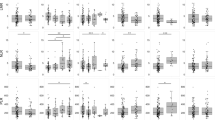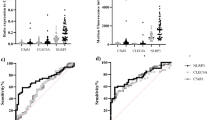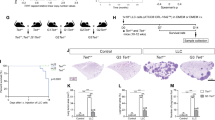Summary
High serum NSE and advanced tumour stage are well-known negative prognostic determinants of small cell lung cancer (SCLC) when observed at presentation. However, such variables are reversible disease indicators as they can change during the course of therapy. The relationship between risk of death and marker level and disease state during treatment of SCLC chemotherapy is not known. A total of 52 patients with SCLC were followed during cisplatin-based chemotherapy (the median number of tumour status and marker level assessments was 4). The time-homogeneous Markov model was used in order to analyse separately the prognostic significance of change in the state of the serum marker level (NSE, CYFRA 21-1, TPS) or the change in tumour status. In this model, transition rate intensities were analysed according to three different states: alive with low marker level (state 0), alive with high marker level (state 1) and dead (absorbing state). The model analysing NSE levels showed that the mean time to move out of state ‘high marker level’ was short (123 days). There was a 44% probability of the opposite reversible state ‘low marker level’ being reached, which demonstrated the reversible property of the state ‘high marker level’. The relative risk of death from this state ‘high marker level’ was about 2.24 times greater in comparison with that of state 0 ‘low marker level’ (Wald’s test; P < 0.01). For patients in state ‘high marker level’ at time of sampling, the probability of death increased dramatically, a transition explaining the rapid decrease in the probability of remaining stationary at this state. However, a non-nil probability to change from state 1 ‘high marker level’ to the opposite transient level, state 0 ‘low marker level’, was observed suggesting that, however infrequently, patients in state 1 ‘high marker level’ might still return to state 0 ‘low marker level’. Almost similar conclusions can be drawn regarding the three-state model constructed using the tumour response status. For the two cytokeratin markers, the Markov model suggests the lack of a true reversible property of these variables as there was only a very weak probability of a patient returning to state ‘low marker level’ once having entered state ‘high marker level’. In conclusion, The Markov model suggests that the observation of an increase in serum NSE level or a lack of response of the disease at any time during follow-up (according to the homogeneous assumption) was strongly associated with a worse prognosis but that the reversion to a low mortality risk state remains possible.
Similar content being viewed by others
Article PDF
Change history
16 November 2011
This paper was modified 12 months after initial publication to switch to Creative Commons licence terms, as noted at publication
References
Andersen, P. K., Hansen, L. S. & Keiding, N. (1991). Assessing the influence of reversible disease indicators on survival. Stat Med 10: 1061–1067.
Bates, S. E. (1991). Clinical applications of serum tumour markers. Ann Intern Med 115: 623–638.
Cooper, E. H., Splinter, T. A. W. & Brown, D. A. (1985). Evaluation of a radio-immunoassay for neuron-specific enolase in small cell lung cancer. Br J Cancer 52: 333–338.
Cox, D. R. (1972). Regression models and life tables. J Roy Stat Soc B 34: 187–220.
Gentleman, R. C., Lawless, J. F., Lindsey, J. C. & Yan, P. (1994). Multi-state Markov models for analysing incomplete disease history data with illustrations for HIV disease. Stat Med 13: 805–821.
Grüger, J., Kay, R. & Schumacher, M. (1991). The validity of inferences based on incomplete observations in disease state models. Biometrics 47: 595–605.
Hansen, H. H. & Kristjansen, P. E. G. (1991). Chemotherapy of small cell lung cancer. Eur J Cancer 27: 342–349.
Iannuzzi, M. C. & Scoggin, C. H. (1986). State of the art: small cell lung cancer. Am Rev Res Dis 134: 593–608.
Jørgensen, L. G. M., Osterlind, K., Hansen, H. H. & Cooper, E. H. (1988). The prognostic influence of serum neuron specific enolase in small cell lung cancer. Br J Cancer 58: 805–807.
Jørgensen, L. G. M., Hansen, H. H. & Cooper, E. H. (1989). Neuron specific enolase, carcinoembryonic antigen and lactate dehydrogenase as indicators of disease activity in small cell lung cancer. Eur J Cancer Clin Oncol 25: 123–128.
Kalbfleish, J. D. & Prentice, R. L. (1980). The Statistical Analysis of Failure Time Data, Wiley: New York
Kalbfleish, J. D. & Lawless, J. F. (1985). The analysis of panel data under a Markov assumption. JASA 80: 863–871.
Kay, R. (1986). A Markov model for analysing cancer markers and disease states in survival studies. Biometrics 42: 855–865.
Pujol, J. L., Grenier, J., Daurès, J. P., Daver, A., Pujol, H. & Michel, F. B. (1993). Serum fragment of cytokeratin subunit 19 measured by CYFRA 21-1 immuno-radiometric assay as a marker of lung cancer. Cancer Res 53: 61–66.
Pujol, J. L., Cooper, E. H., Grenier, J., Purves, D. A., Lehmann, M., Ray, P., Dan Aouta, M., Bashir, M., Godard, P. & Michel, F. B. (1994). Clinical evaluation of serum TPS in non-small cell lung cancer. Eur J Cancer 30A: 1768–1774.
Pujol, J. L., Grenier, J., Parrat, E., Lehmann, M., Lafontaine, M., Quantin, X. & Michel, F. B. (1996a). Cytokeratins as serum markers in lung cancer: a comparison of CYFRA 21-1 and TPS. Am J Res Crit Care Med 154: 725–732.
Pujol, J. L., Parrat, E., Lehmann, M., Gautier, V., Daurès, J. P., Michel, F. B. & Godard, P. (1996b). Lung cancer chemotherapy: methods of response evaluation and response–survival relationship. Am J Res Crit Care Med 153: 243–249.
Sobin, L. H. & Hermanek P. & Hutter, R. V. P. (1987). TNM Classification of Malignant Tumours, 4th edn. UICC: Geneva
Tisi, G. M., Friedman, P. J., Peters, R. M., Pearson, G., Carr, D., Lee, R. E. & Selawry, O. (1982). American Thoracic Society: clinical staging of primary lung cancer. Am Rev Res Dis 125: 659–664.
Van Der Gaast, A., Schoenmakers, C. H. H., Kok, T. C., Blijenberg, B. G., Cornillie, F. & Splinter, T. A. W. (1994). Evaluation of a new tumour marker in patients with non-small cell lung cancer: CYFRA 21-1. Br J Cancer 69: 525–528.
World Health Organization (1979). WHO Handbook for Reporting the Results of Cancer Treatment 48: WHO Offset Publication: Geneva
World Health Organization (1982). The World Health Organization histological typing of the lung tumours, 2nd edn. Am J Clin Pathol 77: 123–136.
Author information
Authors and Affiliations
Rights and permissions
From twelve months after its original publication, this work is licensed under the Creative Commons Attribution-NonCommercial-Share Alike 3.0 Unported License. To view a copy of this license, visit http://creativecommons.org/licenses/by-nc-sa/3.0/
About this article
Cite this article
Boher, JM., Pujol, JL., Grenier, J. et al. Markov model and markers of small cell lung cancer: assessing the influence of reversible serum NSE, CYFRA 21-1 and TPS levels on prognosis. Br J Cancer 79, 1419–1427 (1999). https://doi.org/10.1038/sj.bjc.6690227
Received:
Revised:
Accepted:
Published:
Issue date:
DOI: https://doi.org/10.1038/sj.bjc.6690227



